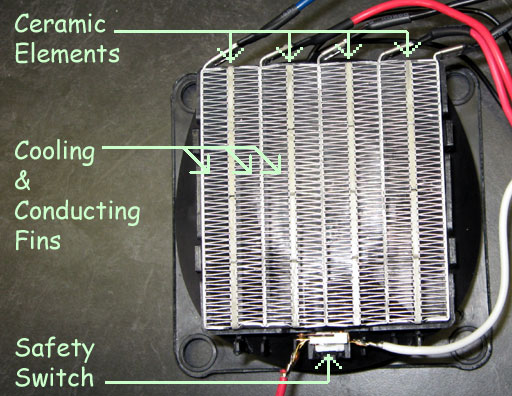The Heater
Original Heater Core

19 October 2008 - The heater core, located within the duct work under the dash of the car, was removed and will be replaced with an electric ceramic heater. The original inspiration for this came from Gavin Shoebride's Electric Vehicle Conversion page.
Sunbeam Ceramic Heater

A Sunbeam ceramic heater was purchased at a local department store for about $30. Much to the dismay of my wife, this heater was not being purchased to heat the bathroom in the morning.
Ceramic Heater Element

The space heater unit was then cracked open and the plastic shrowd containing the ceramic element and fan was removed. The fan will be removed before the installation, but keeping it intact for now will simplify some of the bench tests of the ceramic heater.
The ceramic heater element consists of four stips of ceramic material mounted between aluminum cooling fins, which also serve as conductors. There is also a thermal safety switch that will shut off the power if the unit gets too hot.
The original Sunbeam heater had 2 power levels: Low power would energize the outer 2 ceramic strips and High power would energize all 4 ceramic strips.
The ceramic heater element consists of four stips of ceramic material mounted between aluminum cooling fins, which also serve as conductors. There is also a thermal safety switch that will shut off the power if the unit gets too hot.
The original Sunbeam heater had 2 power levels: Low power would energize the outer 2 ceramic strips and High power would energize all 4 ceramic strips.
120 VAC and 144 VDC Bench Test

A Kill-A-Watt EZ was used to measure the power consumption of different combinations of ceramic strips energized with 120VAC.

Then, while keeping the fan connected to 120 VAC, the 144 V battery pack -- along with the PakTrakr -- was used to measure the power consumption of different combinations of ceramic strips energized with 151-146 VDC from the battery pack.
It's interesting to note that under both test conditions, the initial power consumption of the ceramic strips was much higher when cold and as the element warmed up the power consumption dropped considerably. For example: Initially powering up all 4 strips at 120 VAC would draw more than 2500 watts and then after a few seconds it would drop down to 1566 watts. Note: The unit is only rated at 1500 watts.
Current and power readings were only taken after the power consuption "leveled off." Results are as follows:
The ceramic stips did not appear to be identical and the more strips that were energized during a test would cause the average power consumption per strip to be less. Most likely because more energized strips caused the overall temperature of the element to increase -- fan speed unchanged -- dropping the power consumption per strip.
While my test equipment was not really precision, it seems that this heater unit will behave quite well with a 144 VDC battery pack and a DC relay rated at a minimum of 15A. Two 10A relays could be used to have high and low (1000W - 2000W) power settings.
It can also be assumed that as the blower speed increased the power consumption of the element will increase due to lower element temperature.
It's interesting to note that under both test conditions, the initial power consumption of the ceramic strips was much higher when cold and as the element warmed up the power consumption dropped considerably. For example: Initially powering up all 4 strips at 120 VAC would draw more than 2500 watts and then after a few seconds it would drop down to 1566 watts. Note: The unit is only rated at 1500 watts.
Current and power readings were only taken after the power consuption "leveled off." Results are as follows:
|
| ||||||||||||||||||||||||||||||
|
*Average of several test for a general single element reading. **Variations in pack voltage were recorded and taken into consideration. For anyone that cares, the AC readings are in RMS (effective values). | |||||||||||||||||||||||||||||||
The ceramic stips did not appear to be identical and the more strips that were energized during a test would cause the average power consumption per strip to be less. Most likely because more energized strips caused the overall temperature of the element to increase -- fan speed unchanged -- dropping the power consumption per strip.
While my test equipment was not really precision, it seems that this heater unit will behave quite well with a 144 VDC battery pack and a DC relay rated at a minimum of 15A. Two 10A relays could be used to have high and low (1000W - 2000W) power settings.
It can also be assumed that as the blower speed increased the power consumption of the element will increase due to lower element temperature.